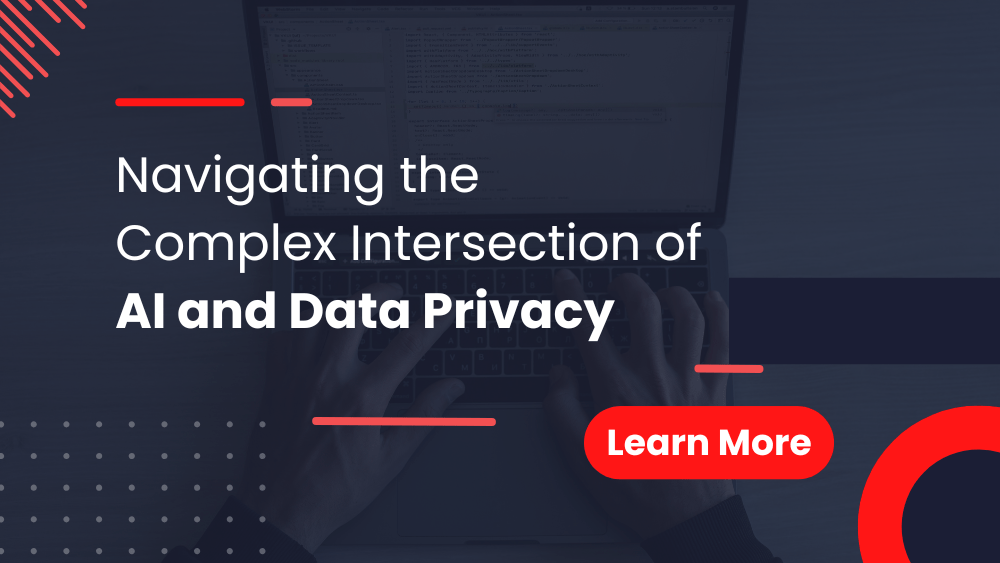The rapid advancement of artificial intelligence (AI) is transforming businesses across various sectors. AI’s ability to automate processes and provide data-driven insights is undeniable.
However, this transformative power comes with a significant responsibility: ensuring the ethical and legal handling of data privacy. The intersection of AI and data privacy is a complex and evolving landscape that demands careful consideration.
Understanding the risks of using AI without robust data protection measures is crucial, as is the need for strong AI data security.
This blog post explores this critical intersection, examining legal requirements, how organizations can leverage the power of AI while implementing AI data privacy protection strategies to ensure ethical and responsible AI development and deployment.
Understanding the Core Issue of AI and Data Privacy
Data privacy, simply put, is the right of individuals to control their personal information and how it’s used. This fundamental right takes on new dimensions in the age of AI. AI systems require vast amounts of data for training and operation to function effectively.
This data often includes sensitive information like financial details, health records, and personal preferences that are collected from different sources such as social media, websites, and sensors.
While this data fuels AI’s capabilities, it also presents significant data privacy risks. For instance, an AI system analyzing social media profiles might infer sensitive information about an individual’s political beliefs, sexual orientation, or medical conditions.
This information could be misused, sold to third parties without consent, or contribute to discriminatory outcomes. This highlights the crucial need for robust AI data privacy policies and practices when implementing AI systems.
Where AI and Data Privacy Collide
The convergence of AI and data privacy is multifaceted. Here are some key areas of intersection:
- Data Collection and Analysis: AI systems thrive on data. The more the data, the better the AI’s performance. However, the collection and analysis of vast datasets, especially those containing sensitive personal information, has some serious privacy concerns. Organizations must ensure transparency and obtain explicit consent before collecting and utilizing personal data for feeding it to AI.
- Machine Learning Algorithms and Bias: Machine learning algorithms are a cornerstone of many AI systems. They learn from the data they are trained on. If this data reflects existing societal biases (e.g., racial, gender, or socioeconomic biases), the AI system will likely perpetuate and even amplify those biases. This can lead to unfair or discriminatory outcomes. This impacts individuals’ rights and opportunities. Addressing these AI bias requires careful data curation, algorithm auditing, and ongoing monitoring of AI systems for discriminatory patterns.
- Behavioral Analysis and Prediction: AI systems can analyze data to predict individual behavior. This capability is beneficial in some contexts (e.g., personalized recommendations). However, it raises some serious concerns about surveillance and potential manipulation. The use of AI for behavioral prediction requires careful consideration of ethical implications and strict adherence to privacy regulations.
- Personalized Advertising and Targeting: AI-powered advertising platforms uses personal data to personalize and target ads to relevant audience. While this can enhance user experience, it also raises questions about the extent to which personal information is used as well as the potential for manipulation or exploitation. Transparency and user control over data usage are crucial in this area.
Mitigating the Risks: Strategies for Responsible AI
Organizations must proactively mitigate the risks associated with AI and data privacy. Key strategies include:
- Implementing Strong Data Privacy Policies and Practices: Organizations need comprehensive data privacy policies that align with relevant regulations (e.g., GDPR, CCPA). These policies should clearly outline data collection practices, data security measures, and individuals’ rights regarding their data.
- Ensuring Data Diversity and Representation: To mitigate bias in AI systems, organizations must ensure the datasets used for training are diverse and representative of the population they serve. This may require active efforts to collect and curate data from underrepresented groups.
- Regularly Reviewing and Monitoring AI Systems: AI systems should be regularly reviewed and monitored for bias, discrimination, and unexpected privacy implications. This ongoing assessment is crucial for identifying and addressing potential issues promptly.
- Conducting Privacy Impact Assessments (PIAs): PIAs help organizations identify and assess the potential privacy risks associated with AI projects before they are implemented. This proactive approach allows for the development of mitigation strategies.
- Data Minimization and Purpose Limitation: Collect only the data necessary for specific AI purposes and avoid collecting sensitive data unless absolutely essential. This principle minimizes the potential for privacy breaches and misuse.
- Data Security and Protection: Implement robust security measures to protect personal data from unauthorized access, use, disclosure, alteration, or destruction. This includes encryption, access controls, and regular security audits.
- Transparency and User Control: Be transparent about how AI systems collect, use, and share personal data. Provide users with clear and accessible information about their data rights and options for controlling their data.
- Staying Updated on Legal and Ethical Developments: The field of AI and data privacy is constantly evolving. Organizations must stay abreast of new regulations, ethical guidelines, and best practices to ensure compliance and responsible AI development.
Conclusion
The intersection of AI and data privacy is a complex and dynamic landscape. It requires a collaborative approach involving organizations, policymakers, and individuals. By implementing robust data privacy policies, promoting ethical AI development, and fostering transparency and user control, we can harness the transformative potential of AI while safeguarding fundamental privacy rights. The future of AI depends on our ability to navigate this intersection responsibly and ethically. Addressing the risks of using AI without proper consideration for AI and data privacy is crucial. This includes understanding the potential for AI data security breaches and implementing strategies for AI in data privacy protection. A proactive and comprehensive approach is essential to mitigate these risks and build trust in AI systems.
FAQs
Q: What are the biggest risks associated with AI data privacy?
A: The biggest risks include data breaches, discriminatory outcomes due to biased algorithms, unauthorized surveillance, and the misuse of sensitive personal information. These risks necessitate robust data protection measures and ethical AI development practices.
Q: How can organizations ensure compliance with AI data privacy regulations?
A: Compliance requires implementing strong data privacy policies, conducting privacy impact assessments, ensuring data security, obtaining informed consent, and staying updated on evolving regulations like GDPR and CCPA. Regular audits and internal training are also essential.
Q: What role does transparency play in addressing AI data privacy concerns?
A: Transparency is paramount. Organizations must be open about how they collect, use, and share personal data for AI purposes. Providing users with clear information and control over their data fosters trust and reduces privacy risks.









